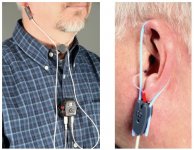I may soon be able to "know" better. I have some small mics that will drop down into my ear canals. I can use them to measure a speaker that is fairly flat, then measure headphones. From there the difference should be easy to find. Will an EQ based on measurements inside my ear canals be better? Maybe. Worth a try, anyway.
...small mics that will drop down into my ear canals. ....
Literally small mikes? Or tube-probe mikes?
The standard in clinical audiology "Real Ear Measurement" is a probe mike tube within 10mm of eardrum, and a "room" mike near the ear. Image. There's two mikes in the box, probably Knowles mini electrets. One just reads the room. One has a long tube which is carefully put deep in the ear. Before that the tube is set in the notch so its end is over the ambient hole, for calibration.
Attachments
Literally small(ish) mics. Just 6mm capsules, but they fit.
David Griesinger helped me some with ear tube mics like he uses, but I could never get them to work well. There was far too much sound leakage from the sides of the tube vs how much was getting into the end of the tube. I abandoned the idea.
David Griesinger helped me some with ear tube mics like he uses, but I could never get them to work well. There was far too much sound leakage from the sides of the tube vs how much was getting into the end of the tube. I abandoned the idea.
So maybe I just haven't been listening to decent headphones then if I'm finding that speakers sound much better... is it atleast normal to feel like speakers have better clarity than comparable headphones? I mean I think that would make sense to me because most headphones are driven off of crappy smartphone amps and speakers have dedicated amplifiers and separate drivers to handle each frequency range, so I would think they would naturally sound cleaner, right? Or am I wrong?
Listening music through headphones vs. through loudspeakers is completely different. Some of the reasons:
Listening through speakers generates not only direct but also reflected sound, just like any natural source (speech, musical instrument) in the same listening room. If reflected sound is missing, there is lack of naturalness.
The sound source is several feet (or meters) away, just like in real life.
You hear both stereo sources with both your ears, there is natural crosstalk. This is time delay and frequency influenced by your head, which you have accustomed to since your birth.
Localization is assisted by head movement (micro or macro) which is impossible with a HP.
Simply put, musical recordings are not meant to be played back on headphones. Think about a recording session: the recording engineer is mixing the desired sound on speakers (heaphones are used by the artists only for monitoring purposes).
Listening through speakers generates not only direct but also reflected sound, just like any natural source (speech, musical instrument) in the same listening room. If reflected sound is missing, there is lack of naturalness.
The sound source is several feet (or meters) away, just like in real life.
You hear both stereo sources with both your ears, there is natural crosstalk. This is time delay and frequency influenced by your head, which you have accustomed to since your birth.
Localization is assisted by head movement (micro or macro) which is impossible with a HP.
Simply put, musical recordings are not meant to be played back on headphones. Think about a recording session: the recording engineer is mixing the desired sound on speakers (heaphones are used by the artists only for monitoring purposes).
An Experiment
I bought some Roland CS-10EM earbud/microphones to experiment with crossfeed.
Today I plugged the microphone part into the MIC input of my PC, drove my headphones from my RME ADI-2 PRO, and used REW to run some frequency response graphs.
The headphones are the Beyerdynamic DT1990, and Hifiman HE400i.
The DT1990 has an 8kHz peak which I suppressed with the EQ on the ADI-2.
I noticed that the HE400i had to have 1/12th octave smoothing in REW, like my loudspeaker measurements which get jagged at high frequencies, but the DT1990 didn't require any smoothing.
I, too, wonder why all published headphone FR measurements are jagged at high frequencies, and why the EQ for the DT1990 worked equally well for the HE400i The results I got were a lot smoother than those that I have seen published.
I bought some Roland CS-10EM earbud/microphones to experiment with crossfeed.
Today I plugged the microphone part into the MIC input of my PC, drove my headphones from my RME ADI-2 PRO, and used REW to run some frequency response graphs.
The headphones are the Beyerdynamic DT1990, and Hifiman HE400i.
The DT1990 has an 8kHz peak which I suppressed with the EQ on the ADI-2.
I noticed that the HE400i had to have 1/12th octave smoothing in REW, like my loudspeaker measurements which get jagged at high frequencies, but the DT1990 didn't require any smoothing.
I, too, wonder why all published headphone FR measurements are jagged at high frequencies, and why the EQ for the DT1990 worked equally well for the HE400i The results I got were a lot smoother than those that I have seen published.
- Status
- This old topic is closed. If you want to reopen this topic, contact a moderator using the "Report Post" button.
- Home
- General Interest
- Everything Else
- Why do headphones seem to measure so poorly?
